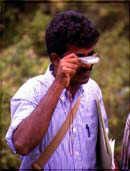|
 |
R.
Siddappa Setty,
a researcher from
Bangalore, India, using a
compass during the People
and Plants Certificate
Training Course in
Applied Ethnobotany (CTC)
held at Kinabalu Park,
Sabah, Malaysia.
© Gary J. Martin |
|
|
Research
Techniques
As I was writing the Ethnobotany
Methods Manual, I
realized that I would never be
able to cover all research
techniques used in qualitative,
quantitative and applied
ethnobotanical research. The
field is vast, and ethnobotanists
draw upon methods from many
different academic fields and
research traditions.
When I have used my manual in
training courses and workshops, I
discovered the need for a
complementary volume of field
research techniques that could be
summarized in two or three pages.
I have not been able to sit
down to write this ethnobotanical
field exercise manual, but I hope
that this section of People
and Plants Online can meet
some of the demand for field
training materials.
|
|
| For the time, I have written up one
technique (Finding
geographical positions with a GPS
Receiver) that can serve as an
example, hopefully stimulating other
contributions. In a few years, I hope
that all contributions can be compiled
into a single publication for fieldwork
and teaching. This part of People
and Plants Online is designed to
permit easy printing of the research
techniques, allowing you to use them in
teaching or in the field. Please
acknowledge People and Plants Online,
and the author(s) of particular
techniques in any publications or other
use of the techniques described here.
|
If you would like to share a
technique with colleagues, we suggest
that you use one of the following
formats. The simple one is for those
contributors who wish to give a basic
idea of the technique, the tools required
and how to do it, illustrated by an
example from the field; it contains notes
on helpful illustrations and references.
If you are feeling ambitious, use the
detailed format, which requests
additional information on background
concepts, useful facts, tips, alternative
methods and addresses. Don’t forget
to let us know who prepared the
description.
Simple
format
|
| Name of Research
Technique : |
| Required Tools : |
| Description : |
| How to do it : |
| Helpful
Illustrations : |
| Example : |
| References : |
| Prepared by: |
Detailed
format
|
| Name of Research
Technique : |
| Required Tools : |
| Description : |
| Background
concepts : |
| Useful facts : |
| Alternative
methods : |
| Applications : |
| Related exercises
: |
| How to do it : |
| Tips : |
| Helpful
Illustrations : |
| Example : |
| References : |
| Useful Addresses
: |
| Prepared by : |
|
| |
|
| Resources | About Us
| What's New
| Notice
Board | Opinion
| FAQ
| Archive
| Feedback
| Main |
 |
|
People
and Plants Online website manager: Gary J.
Martin,B.P. 262, 40008 Marrakech-Medina,
Marrakech, Morocco;
Fax +212.4.329544, e-mail peopleandplants@cybernet.net.ma
Website design & maintenance by RAM Production
Sdn. Bhd.
People and Plants Online © WWF, UNESCO and Royal
Botanic Gardens, Kew |
Disclaimer
Links to other websites cited in
People and Plants Online do not imply endorsement
of these sites or their content
by the People and Plants Initiative or its
sponsoring institutions |
|